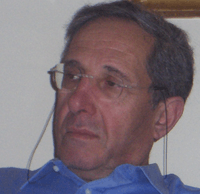Mauro Forghieri
| Mauro Forghieri | |
|---|---|
 Forghieri in 2005 | |
| Born |
13 January 1935 Modena, Italy |
| Nationality | Italian |
| Occupation | Formula One car designer |
Mauro Forghieri (born January 13, 1935) is an Italian mechanical engineer, best known for his work as a Formula One racing car designer with Scuderia Ferrari during the 1960s and 1970s.
Early life
Forghieri was born in Modena, the only child of Reclus and Afra Forghieri. His father, a turner, did war work during World War II for the Ansaldo mechanical workshops of Naples. After the conflict, he took up work in the Ferrari workshop in Maranello. Meanwhile, Forghieri completed the Liceo Scientifico and obtained a degree in Mechanical Engineering from the University of Bologna.
Ferrari
Despite his initial interest in aviation design, he accepted an offer from Ferrari, where he had been introduced by his father.
Having had a very unsuccessful 1962, Ferrari signed British Motorcycle World Champion John Surtees for the 1963 Formula One season, a driver with a background in motor vehicle engineering. Forghieri became Chief of the Technical Department for racing cars, and then was promoted after the departure of Carlo Chiti. With Surtess feedback, Forghieri designed the V8-powered Ferrari 158, in which Surtees won the 1964 Formula One World Championship. Forghieri was later promoted to Technical Director of the Racing Department.
In 1970, Forghieri designed the Ferrari 312 series (consisting of the 312 and 312B formula one cars and 312P and 312PB sportscars). He also designed the first transversal automatic gear and Ferrari's first turbo-compressed engine. Under his guidance Ferrari won the driver's F1 world championship title four times, with John Surtees (1964), Niki Lauda (1975 and 1977), and Jody Scheckter (1979). Ferrari also won the constructors F1 world championship title eight times.
Lamborghini and Bugatti
After leaving Ferrari in 1987, Forghieri joined Lamborghini Engineering, a department created by Lee Iacocca, the then CEO of Chrysler, who had bought the Emilian car firm Lamborghini.
In that organisation, which had the ex-Ferrari Daniele Audetto as sports director, Forghieri designed the naturally aspirated Lamborghini 3512 V12 engine, which made its racing debut at the 1989 Brazilian Grand Prix. The V12 engine was used exclusively by the Larrousse team in the 1989 F1 season.
Following the encouraging performance of the engine, the project of designing a whole car was conceived, thanks to financing by the Mexican businessman Fernando Gonzalez Luna. The car, whose bodywork was designed by Mario Tolentino, was slated for a 1991 debut, but the day before the official presentation to the press, Gonzalez Luna disappeared with a conspicuous amount of money that had been paid by sponsors. Nevertheless, the car debuted thanks to financing by Carlo Patrucco, of the newly created Modena Team (also known as Lambo).
The latter was an unsuccessful enterprise, however, and Forghieri left Lamborghini soon afterwards. In 1992, he became the technical director of the re-emerging Bugatti, where he stayed until 1994. In the same year, he was also called as an expert in the trial relating to the death of driver Ayrton Senna on the Imola track.
Oral Engineering Group
In 1994, Forghieri co-founded with Franco Antoniazzi and Sergio Lugli the Oral Engineering Group, a mechanical design company he still works for. Their projects there have included making the Ferrari Pinin concept car actually run.
References
- Mauro Forghieri's Biography ISBN 978-88-09-06209-2
- Forghieri, Mauro; Buzzonetti, Daniele. La Ferrari secondo Forghieri - dal 1947 ad oggi. Nada. ISBN 978-88-7911-537-7.
External links
| Wikimedia Commons has media related to Mauro Forghieri. |
- Grand Prix History – Hall of Fame, Mauro Forghieri